
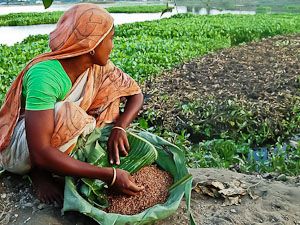
Because agriculture is the most sensitive of all economic sectors, countries and regions most dependent on the environment will not only witness increased illness and escalating death rates due to the heat, but also persistent poverty and deteriorating infrastructure.2 The cumulative effects of climate change on water supplies and farming systems, and the habitability of such areas, will provoke drastic economic and cultural impacts by broadening the divide between those who can afford to adapt and those who do not have the money, knowledge or time to do so.3
Conversely, victims of climate change are potential agents of solutions, leadership, climatic wisdom and untapped contributions to Western science. Through the increasingly popular anthropological method of collecting traditional ecological knowledge (TEK) in climatically vulnerable areas, scientists and anthropologists have slowly recognized indigenous groups as possessors of information critical to the study of climate change. The value of their knowledge and potential contributions to the reduction of global inequalities will be explored below.
Although the debate of whether or not climate change is a human-generated phenomenon still rages on and many politicians prolong any governmental policy concerning contested predictions about a planet warming beyond recovery, climate scientists overwhelmingly agree that the average global temperature continues to increase as a result of anthropogenic (human-caused) greenhouse gas emissions and deforestation.4 The combination of gases such as carbon dioxide, methane, nitrous and sulphur oxides, and chlorofluorocarbons in the atmosphere has contributed to the planet's ability to trap heat and thus alter climatic behavior. Based on current trends of climate change, average global temperatures should rise by three degrees Fahrenheit (two degrees Celsius) over the next fifty to seventy years, a shift that could prove devastating.5
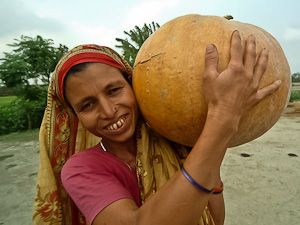
Conversely, regions of Africa making minimal contributions to environmental pollution have, nonetheless, suffered measureable consequences, including an average temperature increase of more than 1.8 degrees Fahrenheit (one degree Celsius) over the past twenty years.7 Sudden climate change can have especially disastrous effects on a continent where one third of the land mass is used for agricultural practices; 75 percent of the population lives in rural areas; and almost all of the labor force is engaged in agriculture.8 Signs, such as weather patterns and animal migrations, that dictate planting and harvesting cycles could become unpredictable or even unavailable altogether, meaning crop yields decline and lead to increased rates of hunger, disease and fatalities.
The Inter-governmental Panel on Climate Change projects that by 2020, seventy-five to 250 million Africans could be exposed to increased water stress.9 These predictions are crucial to consider in terms of inequalities arising as a result of globalization; Africa emits only four percent of the world's greenhouse gases, yet will struggle with immense environmental, cultural and political burdens as a result of the industrialized world's emissions.10
The cultures of rural indigenous peoples worldwide are also at the mercy of climate change. Regional infrastructure and material culture – those tangible aspects of culture such as artifacts, architecture, and art – are constructed with locally-available natural resources now being threatened. It is also possible that non-tangible aspects of culture such as customs, stories, myths, and songs, as well as entire languages tied to a culture's place of origin, will face extinction. This is due to the possibility of increasingly uninhabitable rural locations forcing members of rural cultures into urbanized environments, thereby rupturing ties to homelands.11 The threat is not so much a result of indigenous peoples' inability to adapt to disturbances in climate, but rather their vulnerability to such rapid changes to which adjusting would require much more time for preparation and less frequency between disturbances.12
Ecological problems can quickly become social problems, as civil peace could disintegrate and threaten access to food, water, energy sources, income and health care for the socially disadvantaged. Management of many of the world's international rivers could become areas of contestation, as conflicts over water rights continue to rise.13 Clashes over land rights are likely to become pronounced, as well. Indigenous groups are often those unrecognized by the state and excluded or marginalized from political decision-making.14 As global warming increases and resources become scarcer around urban centers, some indigenous groups will likely face diminished land ownership rights as a result of allocation decisions administered by the state.
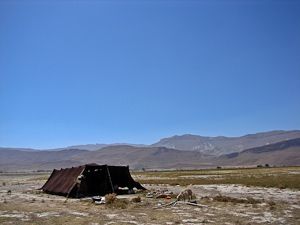
In Bolivia, for example, the National Meteorological and Hydrological Service noted that the rainy season in the Altiplano – the arid land covering much of Bolivia – has contracted from six to three months in recent years. Such drought, compounded with the loss of the 18,000-year-old Chacaltaya glacier that once fed the region's water supplies, has prompted water rationing in Bolivia's major cities. On April 16, 2010, nine hundred comunarios, or communal peasants, largely of indigenous ethnicity, staged a protest against Japanese-owned Minera San Cristobal mine in the Nor Lipez province (situated in the Altiplano), which was using 1.7 million cubic feet of water on a daily basis, free of charge. The peasants burned the company office, overturned two rail wagons – loaded with twenty tons of lead, silver, and zinc ore – and barricaded the rail line that regularly transported the ore to Chile. The comunarios, who had been petitioning the local government for months requesting that the mining company pay local communities for water use, were becoming further entrenched in poverty at the expense of industrialization – instigated by a foreign company, no less.
Such events prompted Bolivian President Evo Morales to publicly condemn climate change and increasing water shortages as consequences of the over-consumption of fossil fuels by rich nations. He stated that poor people everywhere bear more of the risks associated with an unpredictable climate. He also asserted that indigenous cultures should be called upon for their informed, grassroots leadership regarding questions of ecological transformations.16 Such a scenario could empower indigenous people through collective political action, bringing them to the forefront of the climate debate.
The sort of wisdom that Morales is referring to has been termed by scholars Traditional Ecological Knowledge, defined as, "...a cumulative body of knowledge, practice, and belief, evolving by adaptive processes and handed down through generations by cultural transmission, about the relationship of living beings (including humans) with one another and with their environment".17 TEK has become an asset to climate change research, collected largely by anthropologists; it provides a local, qualitative scale of analysis for questions about weather patterns, animal migrations and adaptation strategies. Creating links between local and global conditions offers a wider range of knowledge and, therefore, a more comprehensive toolkit for understanding the biosphere.
The use of TEK has inspired criticism from those skeptical of knowledge not derived from the modern scientific method. Many scientists, academics and politicians have been quick to lump TEK with superstition, irrationalism and tribalism.18 While Western science leans toward an academic presentation and favors analytical/reductionist methods, TEK can be characterized as intuitive and holistic. In addition, it is often orally transmitted rather than written. By characterizing TEK as irrational and superstitious, scientists perpetuate a historical belittling of indigenous culture as backwards, emotional, and ignorant – discriminatory ideas deeply embedded in colonial history. Such attitudes fail to realize the potential for indigenous knowledge to meaningfully contribute to Western science.
However, as a result of the promotion of TEK by those insisting on an inter-disciplinary approach to climate change, Western science has been subject to scrutiny, as well. Arguments state that cultural, economic and political contexts of human adaptation can inform and guide policy related to climate variability in more nuanced and effective ways than Western science alone. For example, scientific approaches to climate change have advocated mega-projects such as dams, which have led to vast human displacement (including place-based indigenous populations). The Three Gorges Dam in China and the Belo Monte Dam in Brazil are two recent examples. Both dams were proposed as "clean development" to address global climate change. Yet, such projects pose serious problems for indigenous cultures – affecting regional agriculture, biodiversity, a diverse array of ecosystems, even culturally significant archaeological sites.19,20
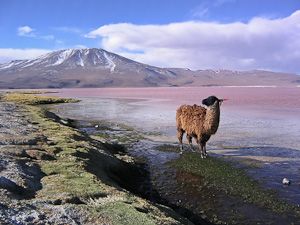
Most importantly, quantitative/biophysical data not only neglects to describe accurately the complexity of interactions between humans and the climate, but its methods can fail to record key climatic features. A study performed by anthropologist Andrei Marin, dedicated to gathering weather information from nomadic herders in Mongolia, found long-term climate trend analysis ignored extreme yet short-lived weather events, such as droughts and dust storms. Local understanding of climate was seen to contradict larger scale meteorological records, which neglected the fact that combinations of short-lived yet more frequent events drastically affected the nomadic lifestyle. The study also concluded that a pastoral way of life better lent itself to the collection of accurate climate data: nomads gathered environmental knowledge over larger areas and with finer spatial clarity – providing more detailed descriptions of these areas – whereas weather stations only registered infrequent point occurrences of weather patterns.23
This study reinforces the idea that it would be insufficient to assess increasingly erratic environmental conditions without incorporating TEK into the analysis. For example, a climate study in Tanzania sought to assess human responses to drought conditions in 1997 and 1998 via qualitative, anthropological research alongside virtually-conducted vegetative biomass research. By developing relationships with Maasai herders and inviting their appraisal of local events, researchers collected vital information about herd movements and livelihood preservation strategies. This data was then combined with quantitative, biophysical data and used to extrapolate economic consequences of drought on a broader, regional scale. Because of the close relationship with Maasai herders, the study was able to propose adaptation solutions, such as administering advance warnings that could help pastoralists shift their livestock practices to cope with climate variability more effectively.24
In addition to the threat climate change poses for indigenous groups, it also affects biological diversity of all kinds. Many communities are potential libraries of ethno-botanical information and can make invaluable contributions to conservation policy by sharing taxonomic knowledge and ecosystem management approaches. Such communities are in a position to provide much-needed innovation in the fields of biotechnology and modern medicine – information that could perish with certain vulnerable plant species. Those who have historically dealt with regular climatic disturbances can also suggest innovative agricultural techniques that can bolster food security.25
By monitoring adaptation strategies among indigenous peoples and organizing a system to disseminate such information, disparate cultures could empower one another. The exchange of sustainable technologies between regions with similar agroclimatic and socioeconomic conditions would provide support for farmers coping with similar disturbances. For example, as Bangladesh faces rising water levels, new agricultural technologies have been developed – in particular, the idea of floating gardens. By fashioning rafts out of hyacinths, Bangladeshi farmers are able to plant vegetables on a liquid surface, an idea that could be replicated in other parts of the world, especially in flood prone areas like rural and coastal communities as familiar as those located in Florida or the Netherlands.26
Perhaps most importantly, the anthropological collection of TEK can play a role in helping indigenous peoples advocate for their rights, as not all communities have the experience or platform to pursue collective political action. In places where civil society and advocacy are lacking, assistance may be required to aid those particularly vulnerable to the repercussions of climate change. Anthropologists can serve this function by sharing experiences of indigenous groups within academia; they can be sources of information as well as facilitators. Additionally, they can research and highlight those groups already pursuing political/social action and environmental justice.27
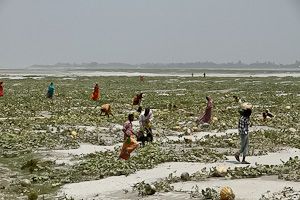
The willingness of indigenous or place-based people to share such information could be problematic, as many groups live in voluntary isolation. Such an exchange needs to operate collaboratively and meaningfully benefit both parties. In terms of TEK, researchers must also consider intellectual property rights of indigenous people and properly compensate them for any financial gains acquired as a result of their participation.
It remains to be seen whether or not people can combine resources quickly enough to expose and mitigate inequalities resulting from climate change. Such a dilemma inspires another anthropological question: Why do humans, as opposed to most other animals on earth, engage in unsustainable relationships with their environment? And, perhaps most importantly, what are the implications of inhabiting a rapidly warming planet where experts needed for understanding and adapting to climate change have yet to be consulted?
Photos are copyright protected and may not be reproduced without permission. Copyright information for images are as follows: 1) Image used with permission of Practical Action 2) Image used with permission of Practical Action 3) Nomadic Camp, photo courtesy of Hamed Saber and used with the permission of Flickr Creative Commons Attribution License 2.0 Generic; 4) Altiplano, photo courtesy of Phil Whitehouse and used with the permission of Flickr Creative Commons Attribution License 2.0 Generic; 5) Pumpkin Farming in Bangladesh, photo courtesy of Shykh Seraj and used with the permission of Flickr Creative Commons Attribution License 2.0 Generic
REFERENCES
1Thomas, David S.G. and Chasca Twyman."Equity and Justice in Climate Change Adaptation Amongst Natural-Resource-Dependent Societies." Global Environmental Change 15 (2005):115-24.
2Steger, Manfred B. Globalization: A Very Short Introduction. Oxford University Press, Oxford; New York:2009.
3Wisner, Ben. "Climate Change andCultural Diversity." Editorial. UNESCO 2010:130-40.
4Broder, John M. "Climate-ChangeDebate Is Heating Up in Deep Freeze." New York Times 10 Feb. 2010.
5Steger.
6"Millennium Development Goals Indicators." Carbon dioxide emissions (CO2). United Nations, 2010. Web. 7Jun 2011.
7Steger.
8Thomas and Twyman
9Wisner.
10Millennium Development Goals Indicators.
11Wisner.
12Crate, Susan A. "Gone the Bullof Winter? Grappling with the Cultural Implicationsof and Anthropology's Role(s) in Global Climate Change." Current Anthropology 49.4 (2008):569-95. Web. 28 Apr. 2011.
13Wisner.
14Mauro, Francesco, and Preston D.Hardison. "Traditional Knowledge of Indigenous and Local Communities:International Debate and Policy Initiatives." Ecological Applications 10.5 (2000):1263-269.
15Thomas and Twyman.
16Weinberg, Bill. "Bolivia's NewWater Wars: Climate Change and Indigenous Struggle." NACLA Report onthe Americas Sept. 2010:19-24.
17Berkes, Fikret. "Rediscovery of Traditional Ecological Knowledge as Adaptive Management."Ecological Applications 10.5 (2000):1251-1262.
18Mauro and Hardison.
19Debatty, Regine."Flotsam, Jetsam andthe Three Gorges Dam". World Changing.com. 2007.
20"An Ecosystem at Risk." Amazon Watch. 2000-2011. Web. 7 June 2011.
21Magistro, John, and Carla Rancoli. "Anthropologica lPerspectives and Policy Implications of Climate Change Research." Climate Research 91 (2001):91-96.
22Berkes.
23Marin, Anderi. "Riders Under Storms: Contributions of Nomadic Herders' Observations to Analysing Climate Change in Mongolia."Global Environmental Change,Adaptive, Adaptive Capacity to Global Change in Latin America (2010):162–176.
24Magistro and Rancoli.
25 Mauro and Hardison.
26Marzano, Mariella. "Changes inWeather: A Sri Lankan Village Case Study." Anthropology in Action13.3 (2006):63-76.
27 Crate.
28Wisner.
29 Mauro and Hardison.